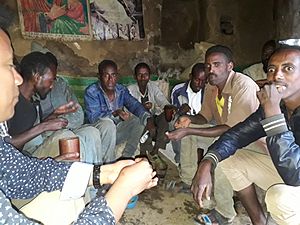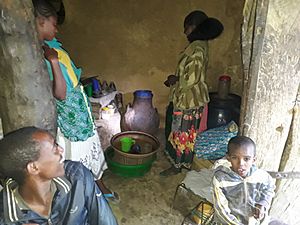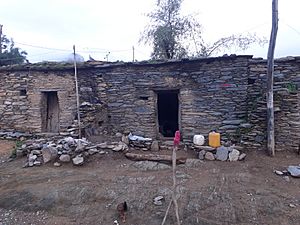Siwa (beer) facts for kids
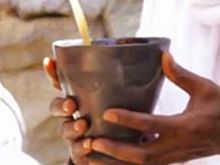 |
|||||||||||
| Location | Tigray, Ethiopia | ||||||||||
|---|---|---|---|---|---|---|---|---|---|---|---|
| Opened | Time of Axumite Kingdom | ||||||||||
| Annual production volume | Est. 400,000 hectolitres (340,000 US bbl) | ||||||||||
| Active beers | |||||||||||
|
|||||||||||
Siwa (also called Suwa) is a special drink from the Tigray area in Ethiopia. It's a traditional beer that families often make at home. Siwa is very popular for social events, after a day of hard work, or as a treat for farmers. You can find thousands of traditional places called Inda Siwa (which means "Siwa house") all over Tigray.
Contents
What is Siwa?
In almost every home in rural Tigray, women know how to make Siwa. The main ingredients are simple: water, a special toasted flatbread, yeast, and dried leaves from a plant called gesho. The flatbread is usually made from barley in the highlands. In warmer, lower areas, it might be made from sorghum, finger millet, or maize.
The mixture ferments for a few days. Then, it's ready to be served! Sometimes, small pieces of bread float in it. The drink has a smoky taste from the toasted bread. It also has a unique mix of sour, bitter, and sweet flavors. Siwa usually has a low alcohol content, between 2% and 5%. After making Siwa, the thicker leftover parts, called atella, are often used to feed farm animals.
Different Kinds of Siwa
There are a few different versions of Siwa:
- Meknen: This is a stronger version of Siwa. People also call it filter, lifter, or tselim siwa. It can have a bit more alcohol than regular Siwa.
- Gu’esh: This is a softer, milder version. It's often made from a second brewing of the Siwa ingredients.
- Korofieh: In the high mountains of Tigray and Amhara, people drink a light version of Siwa for breakfast. It's thick, almost like injera dough.
- Talla and Farso: In the Amharic language, Siwa is called talla. In the Oromiffaa language and in Raya Tigrinya, it's known as farso.
- Myes (Tej): This is a similar traditional drink, but it's made from honey instead of grain. It's Ethiopia's version of mead. Myes is served in special mead houses called inda myes or tej bet. It usually comes in tall, thin glass bottles.
How People Enjoy Siwa
Cups and Containers
Traditionally, Siwa is served in three main types of cups:
- Clay cups called shekhla or wancha.
- Hollowed-out gourds.
- Sometimes, cattle horns.
Today, you might also see people using plastic or metal cups. The stronger meknen is often served in one-liter glass bottles.
Siwa is kept fresh in large clay pots called etriro. These pots are great because they keep the drink cool, especially in hotter areas. Sometimes, plastic drums are used instead of etriro pots.
Siwa in Daily Life
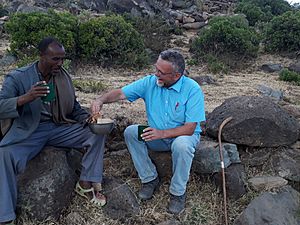
Siwa is an important part of daily life. When farmers work together to plow their land or harvest crops, Siwa is always provided for everyone. If someone is building a house, the owner will often serve Siwa to the workers. It's a way to thank them and keep them refreshed.
Social Gatherings
Siwa is a must-have at almost every social event. This includes baptisms, weddings, and graduation parties. Guests' cups are usually filled to the very top. The host makes sure that cups are refilled quickly, even before a guest can finish their drink!
Inda Siwa: The Traditional Beer House
Almost every village and town in Tigray has one or more Inda Siwa houses. These places are like local cafes or bars. They also help people earn extra money. Inside, you'll find low seats along the walls. People sit together, drink Siwa, and chat. It's a friendly place where people relax and talk freely. If someone new joins a group, everyone will welcome them warmly.
The owner of an Inda Siwa is usually a woman. She keeps track of how many drinks each customer has. Sometimes, customers even help her with the counting!
Young people might visit Inda Siwa to sell snacks like kollo (roasted grains) or buqulti (germinated beans). These snacks are seasoned with homemade mustard. Eating these snacks often makes customers want to order more Siwa.
Some smaller Inda Siwa places only open on certain days of the week. However, all of them are open on market days or the evening before.
Many Inda Siwa are in traditional houses called hidmo. These houses are built with natural stone and have heavy roofs made of stones and earth. They often have a strong wooden column in the center and a beautiful wooden door. Visiting an Inda Siwa is a great chance to see the traditional building style of the Tigrayan people.
Siwa and Modern Beers
As people's lives get better, some wealthier farmers sometimes prefer to drink lager beer from factories. Big breweries have noticed this and have created special beers for farmers. Examples include Balageru (meaning "the rural people") and Azmera beers (meaning "good cropping season").
Even with these new beers, Siwa is still very popular. A music video from 2014 called "Siwa Embeytey" even shows how Siwa is made and how important it is to the community.
Images for kids
-
Farmers sharing Siwa and injera in a field in Lafa, Dogu’a Tembien.


